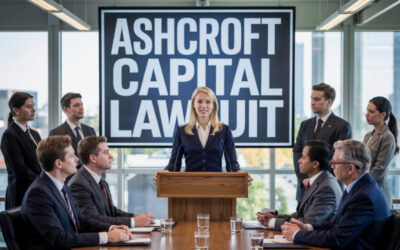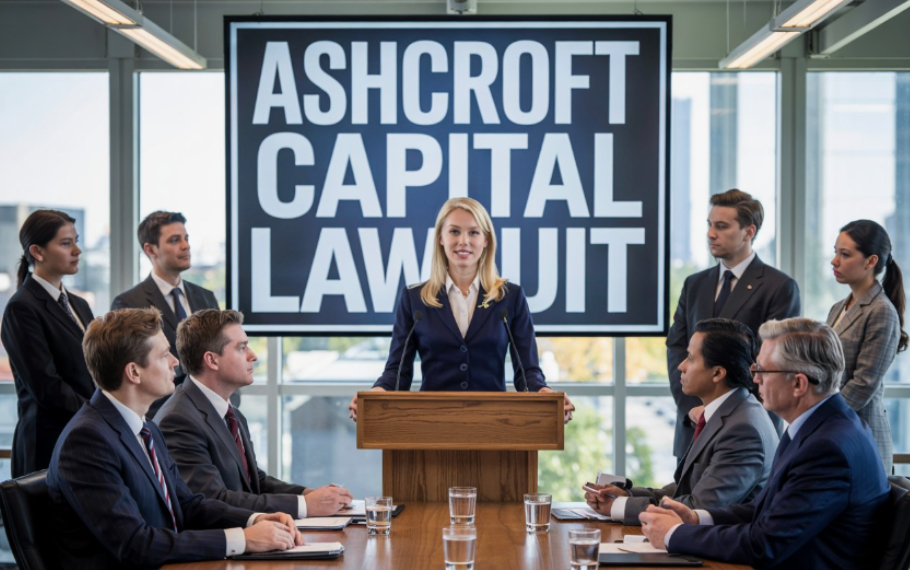The Ashcroft Capital lawsuit has become a prominent topic within real estate investment communities. It evokes strong emotions trust and disappointment, hope and uncertainty. This article aims to guide you through every corner of this situation with compassion and clarity, refraining from jargon and ensuring each point feels like a supportive conversation between friends. Whether you’re an investor, an advisor, or simply curious, may this journey through the Ashcroft Capital lawsuit provide understanding and encouragement.
How did the Ashcroft Capital lawsuit begin?
Everything starts somewhere, and for the Ashcroft Capital lawsuit, that beginning lies in projects that fell short of initial expectations. Around 2022 and 2023, Ashcroft Capital launched a number of multifamily residential developments promising strong rental income and timely completion. As projections were shared, investors felt optimistic. Yet, as months passed, many found themselves waiting waiting for returns that weren’t arriving, timelines that were stretching, and communications that felt vague.
It was during this waiting when assurances met delays and projections matched struggles that investor anxiety grew. What started as casual inquiries turned into formal concerns? In early 2024, a group of investors decided to explore whether their experience went beyond bad luck and reached into the realm of misrepresentation. They shared stories of meetings where optimistic projections were repeatedly quoted, only to see reality simply not align.
Taking this step took courage. It meant evaluating hard questions: Were risks truly explained? Did legal documents match what they were told? Could these delays come down to something more than common market shifts? These questions led directly to the Ashcroft Capital lawsuit, as investors formalized their grievances seeking clarity, accountability, and potentially compensation.
What are the key claims in the Ashcroft Capital lawsuit?
At the heart of the Ashcroft Capital lawsuit lie several core claims. First is the allegation of misrepresentation. Investors say that promotional materials and presentations painted an overly rosy picture of returns and timelines. They now argue that those numbers were not just optimistic they were misleading.
Second is the issue of disclosure. Legal documents, they claim, didn’t fully align with spoken words. Were all costs spelled out clearly? Did each investor receive equal access to risk details? These questions anchored the Ashcroft Capital lawsuit, as plaintiffs pointed to discrepancies between spoken promises and contractual text.
Third is the question of communication post-investment. As delays compounded, several investors found responses slow or unspecific. In the Ashcroft Capital lawsuit, this becomes significant investors argue that delayed or muted communication made it harder to adapt their own plans or even recognize risks sooner.
Finally, there’s the financial impact. Delayed returns, missed cash flow expectations, and unexpected expenses add up. The Ashcroft Capital lawsuit is grounded in the real stress these discrepancies caused beyond legal nuances, it’s about how the investors’ lives were affected.
What’s Ashcroft Capital’s perspective?
In any dispute, there are always two sides. From Ashcroft Capital’s viewpoint, market conditions shifted in ways they couldn’t fully anticipate. Interest rates rose, construction costs spiked, and regulatory timelines extended. None of which were fully within their control. They contend that projections were based on best available data, and risks were outlined in offering documents.
They admit projects faced delays, but emphasize that they communicated proactively. In their view, the Ashcroft Capital lawsuit doesn’t accurately reflect ongoing efforts to manage challenges while caring for investors’ concerns. They assert that even after issues arose, updates were provided, supplemental reports were released, and conference calls were held.
Like all defendants in an investment dispute, Ashcroft Capital sees this as part of doing business managing risk is inherent to real estate. They hope the Ashcroft Capital lawsuit helps clarify misunderstandings, but maintain that they acted in good faith.
The deeper meaning behind the lawsuit beyond financial losses
The Ashcroft Capital lawsuit isn’t only about numbers it’s also about values. When stakeholders feel promises weren’t honored, trust erodes. This case has triggered broader conversations around what constitutes fairness in the real estate world. Is marketing material held to the same standard as legal documents? How transparent should risk disclosure be? When markets shift, how clear must communication be?
Real estate professionals, too, are paying attention. Developers consider whether offering materials adequately reflect uncertainty. Financial advisors are reminding clients to read fine print and ask meaningful questions. And investors are discussing whether to favor firms with longer track records or more conservative projections.In many ways, the Ashcroft Capital lawsuit is shaping more than its parties it influences how real estate is marketed, structured, and managed in the future.
Understanding why investors chose legal action
It’s natural to feel uneasy when expectations aren’t met. But legal action is serious. So why did investors choose that path?For some, the financial impact was substantial. They planned budgeted cash flows around those returns.
When those payments didn’t arrive, their personal finances felt the effect. For others, the story was one of principle. They believed the information provided was not fully accurate or transparent. They felt misled and silenced.
Choosing legal action also offered structure. Lawsuits authorize evidence gathering emails, projections, internal communications. This process can lead to clarity about what was promised, how these statements were made, and who signed off. In that sense, filing the Ashcroft Capital lawsuit helped investors feel they were being heard.
Some lawsuits become public solely for pressure; others aim for full clarity. In this case, some parties are seeking open court proceedings hoping the Ashcroft Capital lawsuit leads not just to restitution, but to broader industry reflection.
Current developments in the legal case
Lawsuit timelines are rarely swift. The Ashcroft Capital lawsuit has passed several early steps. Initial filings were reviewed to verify claims met legal standards. Investigations have begun identifying which projects are involved, which investors participated, and what documents exist.
Discovery is underway a process where both sides exchange internal communication, investment projections, and contracts. That phase is crucial. For the plaintiffs, it provides ammunition to show misalignment between promises and outcomes. For Ashcroft Capital, it’s a chance to validate their approach and clarify their intentions.
Along the way, both sides might file motions asking the court to dismiss certain claims or set parameters on how evidence can be used. Sometimes these motions resolve significant chunks of a case, leaving only narrowed issues. Whether the Ashcroft Capital lawsuit moves toward mediation, settlement negotiations, or a trial depends on how these early phases develop.
The possibility of a negotiated settlement
Many civil cases end in negotiated settlements. A settlement doesn’t mean one side “lost”; rather, it reflects that both parties prefer resolution without prolonged public exposure and expense. In the Ashcroft Capital lawsuit, settlement discussions may already be happening.
For investors, a settlement might mean some reimbursement or project adjustments perhaps even future dividends or equity transfers. For Ashcroft Capital, it would allow them to resolve the dispute discreetly and concentrate on completing projects and maintaining client relationships.
Yet, settlements require both sides to see value in compromise. Plaintiffs must feel the offer reflects their losses and concerns. Defendants must feel the price doesn’t outweigh ongoing risks. If both feel heard, settlement could close the Ashcroft Capital lawsuit quietly. If not, the case may proceed along the judicial path.
Impact of the lawsuit on investors and financial advisors
Whichever way the Ashcroft Capital lawsuit goes, its influence will ripple through real estate practices. Investors will likely become more cautious demanding transparent projections, asking for contingency plans, and trusting firms that clearly articulate both upside and downside.
Legal advisers may recommend including risk mitigation clauses or requiring periodic audits. Because of this case, investment documents may evolve to include more explicit risk disclosures, stronger communication commitments, and even third-party oversight. The Ashcroft Capital lawsuit is prompting a rethink how can clarity be built into every stage of the investment lifecycle?
Advisors may also guide clients to diversify more or invest in properties with deeper track records. Even small decisions like requesting quarterly updates could become standard practice, all tracing back to lessons learned.
Legal protections available to investors
Legal systems exist in part to protect parties who feel harmed. The Ashcroft Capital lawsuit leverages mechanisms like fiduciary duty, fraud statutes, and contract law to assess whether the firm breached trust or provided incomplete information.
Discovery allows investors to request internal documents emails, internal projections, legal counsel communications. They may ask for explanations behind decisions and projections. Depositions give a chance to question executives directly. Through these means, plaintiffs can trace whether assurances matched internal knowledge.
Courts weigh whether breaches were proven clearly and whether damages resulted. If judgments favor investors, they might receive compensation for lost income, reduced property value, or intangible harm like emotional distress or trust erosion.
Even absent a full win, cases like this influence future disclosure norms. Courts may set precedents on what needs to be included in investment marketing. The Ashcroft Capital lawsuit becomes more than one firm’s case it becomes part of the industry’s evolving fabric.
The emotional toll the lawsuit has taken on investors
Beyond the legal and financial dimensions lies human experience. Many investors in the Ashcroft Capital lawsuit describe stress, disappointment, and sometimes embarrassment. They faced delays, communicated uncertainty to family members or business partners, dealt with disrupted plans.
The decision to sue can bring relief even if only to feel heard. It’s an affirmation of one’s rights. It’s a way to push back against blurred expectations and mystery around timelines. In that respect, beginning the Ashcroft Capital lawsuit can bring emotional clarity, even if financial outcomes are still unresolved.
For others, the process feels daunting especially if legal costs, complexity, or public attention feel overwhelming. Support from peers, advisors, or even support groups can help ease the emotional burden. Many find comfort in knowing they’re not alone and that legal systems support investor advocacy.
How the lawsuit may reshape Ashcroft Capital’s practices?
Some firms respond to litigation with transformation. Listening to concerns, they may tighten communication, enhance investor support, or revise documentation processes. Ashcroft Capital may choose to adopt more careful language around projections, introduce third-party audits, or bolster reporting timelines all lessons learned from the Ashcroft Capital lawsuit.
In such a scenario, the case though painful could lead to a stronger, more transparent version of the firm. If the Ashcroft Capital lawsuit acts as a catalyst for positive change, its impact extends far beyond the courtroom.
Key takeaways for other developers in the industry
Developers can look at the Ashcroft Capital lawsuit as a guidepost. It offers insight into investor expectations, market unpredictability, and risks tied to communication. Firms might reconsider how they forecast returns, how they word marketing materials, and how they deliver updates when problems emerge.
If used constructively, the Ashcroft Capital lawsuit becomes a teaching moment. It reinforces that credibility is built on consistency what’s said in glossy brochures, what’s written in contracts, and what investors actually experience. Trust may begin at ‘hello,’ but it’s nurtured every day.
Potential future outcomes of the lawsuit
The future of the Ashcroft Capital lawsuit depends on several factors. Settlement discussions might quiet the case late in 2025. If unresolved, we might see trial proceedings in 2026. These would explore each allegation, evidence, and the context around projections and delays.
Even without a full trial, court rulings on evidence admissibility or motion dismissals may shape outcomes. And if appeals follow, the case history could reach multiple levels offering future guidance on how real estate disputes are framed.
Yet every step forward helps shine light on investor protection, developer responsibility, and the boundaries between hope and promise. Whatever the final chapter holds, the Ashcroft Capital lawsuit will be remembered as a test of transparency and accountability.
Conclusion
As we reach the end of this 2,000‑word exploration, the Ashcroft Capital lawsuit stands out as more than a legal skirmish it represents a conversation about trust, responsibility, and shared vision. For investors, it’s a reminder to ask bold questions and read deeply. For developers, it’s a wake‑up call to align marketing with reality. And for the industry, it offers lessons in humility, clarity, and compassion.
Whether you’re involved in this case or watching from the sidelines, there is value in understanding its ripple effects. The Ashcroft Capital lawsuit could lead to stronger documents, richer communication, and clearer investor protections. It may evolve the real estate industry toward more thoughtful practices ones that respect both optimism and honesty.
In the end, the Ashcroft Capital lawsuit reminds us that behind every investment, every projection, and every return, there are people. People who hope, dream, worry, and act. Recognition of that humanity and a commitment to transparency may be the golden outcome of this journey.























